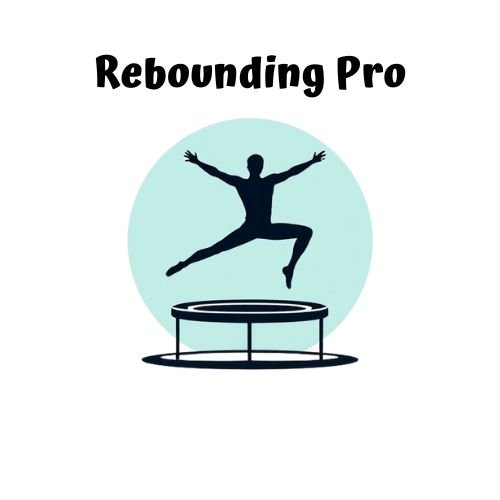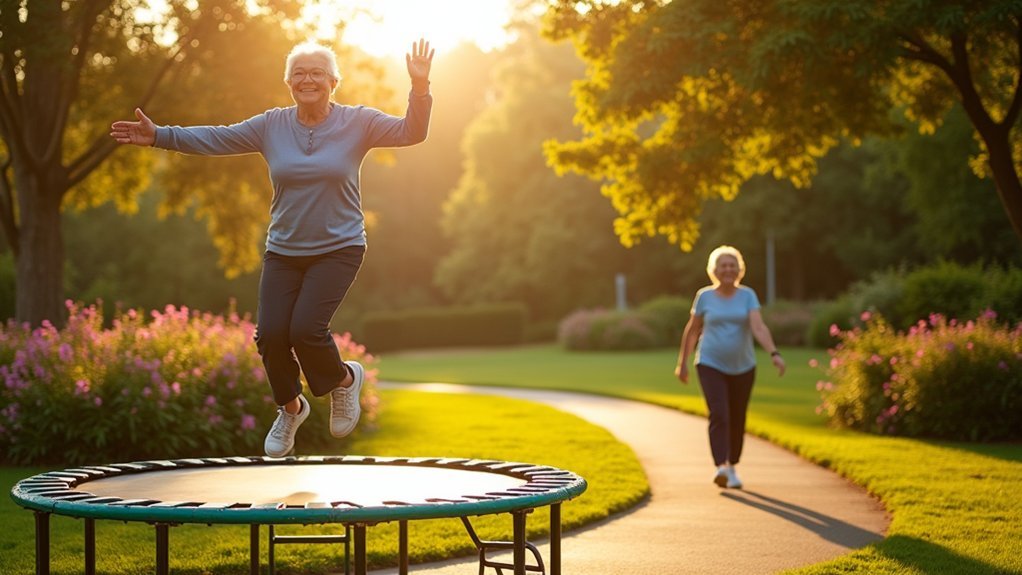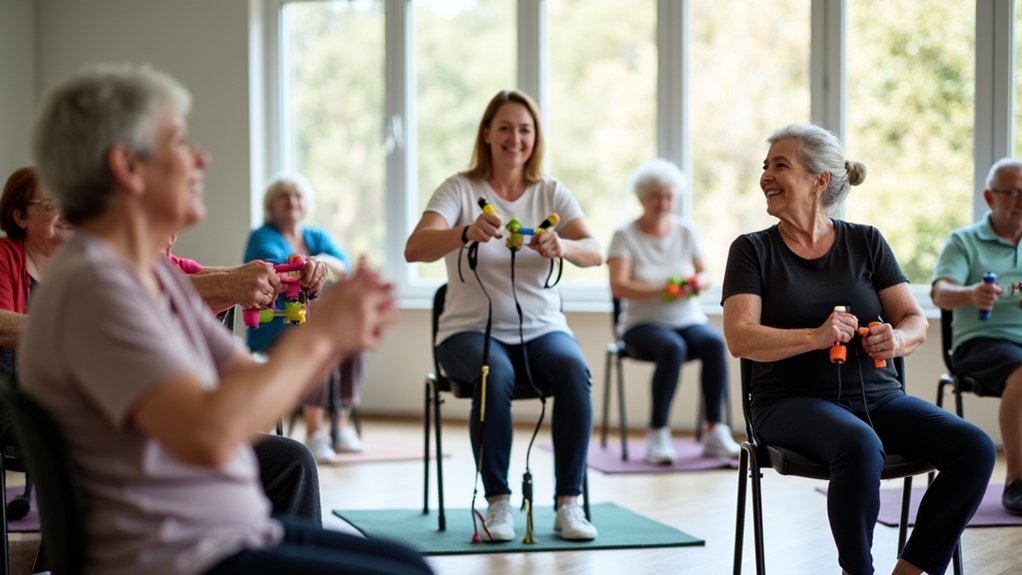Bouncing on mini-trampolines offers gentler joint impact while potentially stimulating bone growth more effectively than walking. You’ll build strength faster with rebounding (5-10 minutes) compared to walking (30+ minutes). For arthritis, try seated bouncing or basic rebounds with support bars. Walking still excels for cardiovascular health, especially at 3+ mph. Choose rubber mats for rebounding and smooth paths for walking to prevent falls. Both activities boost mental health through endorphin release, with enhanced benefits when done in groups or nature settings.
Assessing Your Joint Health Before Choosing Rebounding or Walking

Before commencing any new exercise regimen, you’ll need to thoroughly evaluate your joint health, especially if you’re considering rebounding or walking as an older adult.
Start by using a Joint Health Assessment tool to identify potential issues in your hips, knees, and ankles. Many older adults experience everyday wear and tear that contributes significantly to joint problems as they age.
Pay attention to your range of motion, balance capabilities, and muscle strength—all critical factors in determining which exercise suits your body.
If you’re managing chronic conditions like diabetes or cardiovascular issues, these may affect your joint function and exercise tolerance.
Consider scheduling a geriatric assessment that includes fall risk evaluation, particularly important if you’re leaning toward rebounding.
Your current mobility limitations and weight status will help determine whether low-impact walking or the more dynamic rebounding option is safer for your joints.
Comparing Bone Density Benefits of Gentle Bouncing vs. Daily Strolls
When you compare bone density benefits, you’ll find that gentle bouncing creates higher-impact forces that potentially stimulate bone growth more effectively than walking’s steady pressure.
Your skeleton responds differently to each activity—rebounding tends to affect a wider range of bones throughout your body, while walking primarily strengthens lower limbs and hips.
Both exercises contribute to bone remodeling, but you might experience faster density improvements with consistent rebounding due to its more dynamic stress application on your skeletal system. Studies show that walking requires a brisk pace of at least 2.5 miles per hour to effectively prevent bone loss, making intensity a critical factor for either exercise choice.
Impact Levels Matter
Although both activities support bone health, the force magnitudes generated during gentle bouncing greatly outperform daily walking for stimulating bone formation.
When you bounce, your skeleton experiences forces up to 3 times your body weight, compared to just 1-1.5 times during walking.
This impact difference matters tremendously. Your bones require a minimum threshold of mechanical stress to trigger new bone growth—a principle your daily walks often fail to achieve, especially for upper body bones.
You’ll generate superior mechanotransduction signals through structured bouncing exercises that specifically target multiple skeletal sites. Short bursts of bouncing activity followed by brief rest periods can be particularly effective for bone strengthening.
Walking primarily benefits your lower extremities, while properly executed bouncing can stimulate bone formation throughout your skeleton.
For measurable bone mineral density improvements of 1-3% annually, you’ll need those higher-magnitude, multi-directional forces.
Adaptive Bone Strengthening
The contrast between impact forces becomes clearer when examining how your skeleton adapts to different exercise types. Your bones require specific mechanical stimuli to maintain strength, and not all activities deliver equal benefits. Consulting with a health care provider before starting either exercise regimen is essential, especially for those with diagnosed bone density issues.
| Bone Adaptation Factor | Gentle Bouncing | Daily Walking |
|---|---|---|
| Stimulus intensity | Brief, high-magnitude | Prolonged, low-impact |
| Osteogenic response | 5-10 minutes effective | Requires 30+ minutes |
| Target areas | Superior hip/spine benefits | Better for femoral bones |
| Cellular signaling | Enhances Wnt/β-catenin pathways | Moderate activation |
| Progression potential | Can increase height/reps | Plateaus without weights/inclines |
For ideal results, consider your specific needs. If you have severe osteoporosis, start with walking. Otherwise, incorporating low-amplitude bounces (½-1″ pulses) can provide superior bone stimulation in less time than traditional walking.
Progressive Remodeling Patterns
Progressive bone remodeling differs markedly between bouncing and walking exercises, creating distinct patterns of skeletal adaptation over time.
When you bounce gently, you’re applying rapid, repetitive mechanical forces similar to running, potentially stimulating more intense bone strengthening than walking alone.
Walking requires a minimum pace of 2.5 mph to benefit your bones, with ideal results at 3.1-3.7 mph. While walking primarily strengthens your femoral neck and hip area, bouncing may provide more thorough skeletal loading.
For the best results, consider combining both activities. This varied approach creates different stress patterns on your bones, potentially leading to more complete strengthening while improving adherence to your exercise routine. The OSU study showed that incorporating 50 jumps three days a week significantly reduced bone loss in postmenopausal women compared to those who didn’t perform this exercise.
Remember that consistency is essential—significant improvements in bone health typically emerge only after months of regular activity.
Low-Impact Rebounding Techniques for Arthritis Management
For individuals living with arthritis, finding exercise that doesn’t aggravate joint pain can be challenging. Rebounding offers a solution, reducing impact forces to just 1/6 of pavement walking while strengthening joints and surrounding muscles.
You’ll benefit from several effective techniques: try the basic bounce, keeping your feet on the rebounder while gently moving up and down. For variety, incorporate step touches and heel lifts to improve coordination and strengthen calves.
If you have severe limitations, seated bouncing provides benefits without standing.
Research supports these approaches, with studies showing improved bone density, enhanced balance, and reduced fall risk after just 12 weeks of consistent practice. Rebounding has been shown to be more effective than walking for reducing pain in osteoarthritis patients.
Plus, you’ll enjoy better lymphatic circulation and natural pain relief through endorphin release—all with minimal equipment and adaptable intensity levels.
How Walking Speed Reveals Your Cardiovascular Fitness

While rebounding offers low-impact benefits for arthritis sufferers, your walking pace provides a different kind of health insight.
Your normal walking speed serves as a powerful biomarker for heart health, especially if you’re middle-aged.
Walking at 3+ mph can lower your cardiovascular disease risk by 25-30% compared to slower paces. This brisk tempo (about a 20-minute mile) elevates your heart rate, improves circulation, and enhances metabolic efficiency. Changes in your usual walking speed may be an early warning sign of developing cardiovascular problems.
Each 0.1 m/s increase in speed correlates with roughly 12% lower mortality risk.
If you’re between 50-65, your walking speed is particularly revealing. Speeds below 2.5 mph may indicate cardiovascular concerns, while maintaining a brisk pace suggests better HDL cholesterol levels and overall heart function.
Balancing Fall Prevention With Progressive Rebounding Exercises
Your proprioceptive system gets a significant boost from rebounding exercises, which challenge balance in ways walking alone cannot.
You’ll find that progressive rebounding offers low-impact shifts from basic movements to more challenging routines, making it accessible even if you’re new to exercise.
The surface you choose—whether a mini-trampoline with handrails or a more stable rebounding platform—dramatically affects safety and effectiveness for fall prevention. Incorporating exercises that focus on balance and strength can significantly reduce your risk of falls while improving overall stability during daily activities.
Proprioceptive System Activation Benefits
Maintaining balance and preventing falls depends greatly on a well-functioning proprioceptive system—the body’s internal awareness of position and movement. Both rebounding and walking can enhance this critical system, but they do so differently. Proprioceptors in muscles detect changes in length and tension during both activities, sending vital feedback to the brain to prevent falls.
| Rebounding | Walking |
|---|---|
| Creates multidirectional balance challenges through unstable surfaces | Activates muscle spindles through controlled weight shifting |
| Introduces unpredictable perturbations improving response time | Enhances spatial awareness via consistent feedback during gait cycles |
| Promotes frequent center-of-gravity shifts during vertical oscillation | Builds stability through predictable heel-to-toe shifts |
| Engages core muscles during rhythmic movements | Improves limb-core coordination during normal gait phases |
You’ll benefit most from combining both activities—use walking for fundamental stability and rebounding to challenge your balance systems with novel stimuli that prevent adaptive plateaus.
Low-Impact Progressive Transitions
For older adults, a key question emerges beyond proprioception: how can rebounding exercises be safely introduced and gradually increased? The answer lies in strategic shifts between bouncing and walking on your mini-trampoline.
Start with gentle walking exercises on the rebounder to establish balance and stability. Gradually introduce small, controlled bounces while maintaining proper form. Use support bars if needed during shifts. Maintaining feet fixed position enhances safety and prevents falls while still providing cardiovascular benefits.
As your confidence grows, alternate between walking intervals and bouncing sessions, always respecting your body’s limits. Incorporate closed chain movements where your feet stay in contact with the surface, especially when beginning.
Remember to integrate upper body movements only after mastering the basics. This progressive approach guarantees cardiovascular benefits while minimizing joint stress—making rebounding both effective and sustainable for aging bodies.
Surface Choice Matters
When selecting surfaces for rebounding exercises, older adults must carefully balance safety with progressive challenge. Rubber mats provide excellent shock absorption, reducing joint stress during bounces, while natural grass offers proprioceptive benefits for walking.
For rebounding, choose medium-tension mini trampolines that optimize force distribution and reduce peak ground reaction forces. These surfaces can absorb 30-50% of impact compared to walking. Regular exercise on these surfaces helps mitigate aging consequences and can significantly reduce fall risk among elderly individuals.
Always guarantee non-slip surfaces for high-impact shift phases. If you have osteoporosis, avoid rebounders with greater than 8-inch drop heights, and limit vertical displacement to under 2 inches for those with hip replacements.
Replace worn-out mats every 6-12 months as they can lose 40% of their shock absorption capacity with heavy use.
Creating a Time-Efficient Workout by Combining Both Activities
While many older adults struggle to find time for exercise, combining walking and bouncing activities creates an efficient workout that maximizes health benefits without consuming extra hours in your day. By alternating these complementary movements, you’ll optimize cardiovascular results and maintain interest in your routine. This approach can help older adults reach the CDC recommended 150 minutes of weekly exercise through engaging variety.
| Time | Activity | Benefit |
|---|---|---|
| 3 min | Walking | Builds lower-body strength |
| 3 min | Gentle bouncing | Engages core muscles |
| 10 min | Walking outdoors | Reduces anxiety/depression |
| 5 min | Bouncing intervals | Improves balance/coordination |
| 5-10 min | Combined cool-down | Enhances joint flexibility |
Try starting with a 1:1 ratio for beginners, gradually progressing to 2:1 ratios as your fitness improves. This interval approach delivers comparable benefits to longer single-activity workouts while improving heart rate variability and preventing exercise monotony.
Surface Selection: Optimizing Safety for Each Exercise Type

The surface you choose for both bouncing and walking exercises markedly impacts safety and effectiveness for older adults. For bouncing, select mini-trampolines with elastic bands that absorb shock and feature non-slip handles.
Look for low-profile models (8-12 inches) with adjustable resistance to match your capabilities.
When walking, stick to smooth, paved pathways rather than grass or gravel that increase fall risk. Well-lit routes with less than 5% incline provide cardiovascular benefits without excessive joint strain. High-impact exercises can help strengthen bones and connective tissues when performed with proper technique and appropriate surfaces.
For both activities, proper maintenance is essential—regularly inspect trampoline mats for wear and repair cracks in walking paths.
Consider treadmills with handrails as safer alternatives during inclement weather. Always start with gradual intensity and wear proper footwear with arch support to optimize safety.
Mental Health Advantages: Endorphin Release During Rebounds vs. Walks
When you bounce on a mini-trampoline, your brain releases endorphins more dynamically than during walks, potentially creating stronger mood-boosting effects for older adults.
Walking outdoors, however, combines endorphin release with nature’s calming benefits, amplifying mental health improvements through sensory engagement with trees, sunlight, and fresh air.
Both exercises offer unique social dimensions—rebounding classes foster structured community connection while walking groups or solo strolls provide flexible opportunities for conversation or peaceful reflection. For optimal mental health benefits, consider that exercise intensity significantly influences endorphin production, with higher-intensity activities generally triggering more substantial releases of these feel-good hormones.
Mood-Boosting Chemical Differences
Both rebounding and walking trigger the release of mood-boosting chemicals in older adults, though they achieve this through different pathways and intensities.
High-intensity rebounding typically prompts a more significant endorphin surge, giving you that immediate “feel-good” sensation and anxiety relief.
Walking, while generally producing a more moderate endorphin response, offers consistent mood elevation that’s easier to sustain over longer periods.
You’ll find that your baseline endorphin levels as an older adult may differ from younger individuals, affecting how you respond to each activity.
The social dimension of both exercises enhances their benefits—group walks or bounce classes can amplify mood improvements through social connection.
Your coordination improves with rebounding, potentially boosting confidence and body awareness, while walking’s rhythmic nature promotes cognitive health through improved blood flow. Rebounding activities can significantly contribute to better sleep quality, which further enhances mood regulation and mental well-being in seniors.
Nature’s Amplification Effect
Beyond the chemical differences in your brain, where you exercise greatly influences your mental health benefits as an older adult.
Natural environments amplify the mood-boosting effects of both bouncing and walking activities. When you exercise in rural or natural settings, you’ll experience enhanced endorphin release compared to urban environments.
Even just 20 minutes in nature while bouncing or walking can markedly reduce anxiety levels and stress. The tranquility of natural surroundings creates a synergistic effect—combining physical activity with nature exposure delivers greater mental health improvements than either component alone. Natural settings help overcome mental blocks and can significantly improve your exercise productivity.
For maximum cognitive benefits, consider rural environments which may offer more pronounced improvements to memory, problem-solving, and attention span.
Your creativity also flourishes in natural settings, making your exercise routine not just physically beneficial but mentally rejuvenating.
Social vs. Solo Benefits
Many older adults face a fundamental choice in their exercise routines: engaging with others or embracing solitude. Both bouncing and walking offer distinct advantages depending on your social preferences.
Group activities create valuable support networks—whether you’re joining a trampoline class or a walking club. These social connections reduce isolation and provide motivational feedback that keeps you committed to your fitness journey. Participating in these activities helps reduce symptoms of depression and anxiety through endorphin release during exercise.
- Social bouncing offers novelty and shared fun while releasing mood-boosting endorphins.
- Group walks combine gentle exercise with community engagement, enhancing mental well-being.
- Solo activities provide flexibility, personal reflection time, and freedom from social pressure.
The endorphin release from both activities improves your mood and reduces anxiety, but your preference for company or solitude might ultimately determine which activity feels most rewarding.
Adapting Rebounding Exercises for Different Mobility Levels
Rebounding exercises can be effectively tailored to accommodate various mobility limitations that older adults may experience. You can start with basic positioning by holding onto a stable object for balance while performing gentle bounces or light movements on the mini-trampoline.
If you have reduced mobility, try seated exercises on the rebounder, focusing on leg lifts or arm movements. For additional support, incorporate handrails or a walking stick during your routine.
As you gain confidence, gradually progress to more challenging movements like partial squats or core-strengthening exercises.
You’ll find that rebounding offers balance improvement benefits while being gentle on joints than walking, making it an excellent low-impact exercise option for seniors. Consider working with a fitness instructor who can help customize exercises to your specific mobility level and track your progress over time.
Integrating Social Connections Into Your Walking and Rebounding Routine
While pursuing physical exercise is beneficial on its own, the social aspects of your walking or rebounding routine can dramatically enhance motivation and consistency. Research shows that walking with peers increases autonomous motivation, making you 1.5 times more likely to maintain your routine. 87% of adults age 50+ engage in some form of daily walking activities, showing how common this exercise is among older populations.
Similarly, rebounding classes can create accountability that reduces dropout rates.
- Find a buddy – Partner-based activities boost adherence through mutual encouragement, whether you’re walking neighborhood paths or bouncing on mini-trampolines.
- Join community groups – Weekly walking clubs or rebounding classes at community centers foster goal-sharing and sustained exercise habits over time.
- Use technology – Fitness trackers with social features enable virtual challenges when in-person meetups aren’t possible, maintaining those vital social bonds.
Frequently Asked Questions
Can Rebounding Help Reduce Cognitive Decline in Older Adults?
Yes, rebounding can potentially help reduce cognitive decline. While specific studies are limited, it’s an aerobic exercise that likely increases neurotrophic factors and enhances neuroplasticity, giving you similar cognitive benefits as other physical activities.
How Do Medications Affect the Safety of Rebounding Exercises?
Your medications can greatly impact rebounding safety. Blood pressure drugs may cause dizziness when bouncing, bone density meds require gentler movements, and sedatives increase fall risk. Always consult your doctor before starting.
Are Indoor or Outdoor Walks Better for Vitamin D Absorption?
Outdoor walks are considerably better for vitamin D absorption. You’ll get essential UVB exposure when walking outside during daylight hours, while indoor walks won’t provide any vitamin D synthesis regardless of duration or intensity.
Should Rebounding Be Avoided After Specific Surgical Procedures?
Yes, you’ll need to avoid rebounding after many surgeries including bariatric, implant, or spinal procedures. Always get your surgeon’s clearance, which typically comes 6-12 weeks post-surgery depending on your specific procedure.
How Do Seasonal Weather Changes Impact Exercise Selection and Benefits?
You’ll need to adjust your exercise choices as seasons change. In winter, try indoor rebounding for safety. During spring, you can enjoy outdoor walking’s added vitamin D and mood benefits.
In Summary
You’ve now got the tools to decide what’s best for your body. Whether you’re bouncing on a rebounder or walking through your neighborhood, you’ll maximize benefits by listening to your joints, starting slowly, and progressing gradually. Remember, it’s not about choosing one forever—it’s about finding the right balance that keeps you moving safely while enjoying the journey to better health.





Leave a Reply